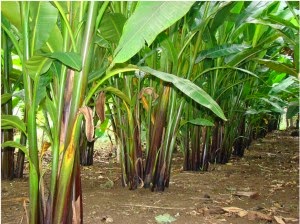
 In Indonesia, abaca production centers located in South Sumatra, Java, and Borneo Sangihe Islands. Indonesia still has one of the manufacturer and exporter of abaca fiber and only abaca plantation development. With the increasing demand for abaca fiber from developed countries
such as Germany, Holland, France, Japan, Spain, Denmark, America,
Britain, and Canada, indicate an opportunity for Indonesia to increase
acreage and production of abaca as non-oil commodities.
In Indonesia, abaca production centers located in South Sumatra, Java, and Borneo Sangihe Islands. Indonesia still has one of the manufacturer and exporter of abaca fiber and only abaca plantation development. With the increasing demand for abaca fiber from developed countries
such as Germany, Holland, France, Japan, Spain, Denmark, America,
Britain, and Canada, indicate an opportunity for Indonesia to increase
acreage and production of abaca as non-oil commodities.Figure abaca, together with the usual banana. What distinguishes it is, abaca slimmer. Can be up to six meters high. Characteristic of abaca is the stem, and brown midrib. Variegated its leaves green with brown, similar to the uniform Army Corps Special Forces. Abaca also does not produce bananas, because the fruit never grow perfectly. As with other banana, abaca grow group with one parent and some plant saplings. Tillers were used as seed in the cultivation of abaca.
Abaca planted tightly spaced, so that growth is rising. With growing upward, will be obtained rod long enough, until the resulting fibers are also long. Age abaca from planting to harvest between 18 sd. 24 months (1.5 - 2 months). Harvest can be done continuously hose 3 to 8 months, for about 20 years. Abaca harvested by cutting the stems. On the banana fruit, harvesting is done in the middle of the trunk. In harvest abaca, logging done on the base of the stem.
Abaca fiber is taken mainly from the shaft. Banana trees, is actually a pseudo-stem, which consists of the fused sheet leaf midrib. Original banana stem weevil which are in the form of land. Sheets of leaf sheath was then be processed to take the fiber. In one diameter abaca stem 30-40 cm, can be obtained between 12 sd. 25 sheets of leaf midrib. In addition consists of cellulose fibers, abaca sheath also contains lignin, and pectin. After lignin and pectin, removed, abaca fiber is referred to as manila hemp or manila.
Excess manila hemp is durable, flexible, and resistant salinity. That is why popular abaca fiber as rope ship, as well as fishing nets. Nylon is more resistant to sea water, but the disadvantages are heat resistant, and easily tangled. In addition to the ropes, manila hemp also popular as a paper (manila papers), including for the manila envelope, as well as fabric. Manila hemp fibers can be spun single, can be mixed with cotton, flax, hemp, rayon, and polyester. Manila hemp fabric material is also very strong, although the quality is not as good as hemp.
Abaca has the advantage of being relatively simple cultivation, compared with hemp, jute, kenaf, and cannabis. The cultivation of hemp to be able to more than 10 years, only suitable at elevations above 500 m. asl. Jute, kenaf, and cannabis is an annual plant, which once planted should be dismantled. Abaca suitable to be cultivated from the lowlands, up to an altitude of 1500 m. asl. in the wet area. Once planted, abaca can be continuously harvested for 20 years. Abaca will also absorb labor, both for the cultivation and process.
Growing ConditionsRequirements grow, which according to the abaca plant is climate type A classification according to Schmid and Ferguson, with rainfall of 2000 - 3000 mm / year and the number of rainy days between 150-200 days. Abaca can grow well in the lowlands to the highlands which reaches an altitude of 1000 m above sea level, with good soil that is loose soil such as clay clayey or sandy loam and do not there is a dense layer.
Seeds used for planting is derived from the parent plant saplings aged 2 to 2.5 years, a spacing of 5 x 3 meters with a population of about 660 plants per hectare, the planting hole is made with a length x width x in is (25-30 cm) x (25-30 cm) x (25-30 cm). Maintenance performed on young plants by tilling the soil and weeding, it periodic disposal leaves have dried up, fertilization is done once a year at the start of the rainy season with the type and dose of fertilizer applied, namely: 1 kg ZA + 1 Kg dolomite per clumps are given in the groove between the rows of plants.
Rejuvenation is done when the plants were aged between 15-20 years also depends on the condition of the plant, how to disassemble the entire plant and not to the remaining stump or seedling-puppies left, then planting the new crop.
Plants begin to be harvested after the age of 2-3 years with the criteria already be felled tree that is when it is out of interest (heart) or near the time the plant will start flowering, heart visible tip of the stem, harvesting lowland faster than the time of harvest in the highlands , how to harvest by cutting the stem at the top of the banana weevil, cuts do not horizontally to prevent accumulation of rain water that causes decay. Abaca productivity per hectare can reach 3 tons of dry fiber every six months.
Cut stems cut along the 110 cm or customized with fiber machine (dekortikator), cut logs and then exfoliated into sheets midrib. Leaf sheaths dekortikator and transported to the engine resulting wet fiber, then squeezed and dried.


.jpg)
.jpg)
.jpg)
.jpg)
.jpg)